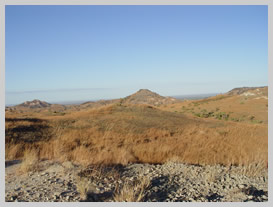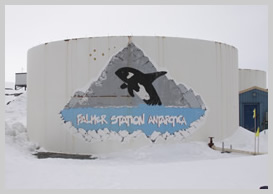Research
Paleontology and Geology Field Projects
I am involved in a number of collaborative field projects, most of which seek to characterize Cretaceous-age (144-65 million years ago) terrestrial and freshwater vertebrates from the southern hemisphere. The fossil record of Cretaceous-age land-dwelling vertebrates from the southern hemisphere is extremely patchy, with many large regions (e.g., sub-Saharan Africa, Antarctica) of the former Gondwanan supercontinent remaining a virtual mystery in terms of what types of animals lived there during the last period of the Mesozoic Era. Even less well understood is how southern hemisphere ecosystems recovered during the early Paleogene after the Cretaceous extinction event.
The projects described below were developed in order to better sample biotas from some of the least well known parts of Gondwana during the tumultuous transition out of the Mesozoic and into the Cenozoic. These descriptions are meant to provide a only brief overview of the projects. Please see the project-specific websites for more information on the background, results, key personnel, and outreach efforts related to each field project.
The Rukwa Rift Basin Project (RRBP)
, southwestern Tanzania
Middle Cretaceous Terrestrial Faunas of eastern Africa
Since 2002 I have directed annual field paleontology efforts in Cretaceous deposits exposed throughout the Rukwa Rift Basin (RRB) in southwestern Tanzania. Working with colleagues from the US, Tanzania, and elsewhere, our team has sought to characterize the various vertebrate fossils preserved in rocks estimated to have been deposited approximately 100 - 75 million years ago. Simultaneous efforts by project geologist Eric Roberts (James Cook University) have sought to establish the stratigraphic, sedimentological, and paleoenvironmental context in which the fossils were deposited. Together the these efforts serve to enhance our understanding the types of animals that once lived in this region of the southern supercontinent of Gondwana and place them in broad paleoecological and paleobiogeographic contexts. It is noteworthy that prior to inception of the project there were no known Cretaceous-age vertebrate fossils known from this region of East African Rift System. More
Hide
Cretaceous deposits exposed throughout the Rukwa Rift Basin (RRB) in southwestern Tanzania. Working with colleagues from the US, Tanzania, and elsewhere, our team has sought to characterize the various vertebrate fossils preserved in rocks estimated to have been deposited approximately 100 - 75 million years ago. Simultaneous efforts by project geologist Eric Roberts (James Cook University) have sought to establish the stratigraphic, sedimentological, and paleoenvironmental context in which the fossils were deposited. Together the these efforts serve to enhance our understanding the types of animals that once lived in this region of the southern supercontinent of Gondwana and place them in broad paleoecological and paleobiogeographic contexts. It is noteworthy that prior to inception of the project there were no known Cretaceous-age vertebrate fossils known from this region of East African Rift System. More
Hide
Over the course of the project our team has discovered a number of highly productive fossil-bearing localities in a rock unit now formally known as the Galula Formation. The developing vertebrate fauna includes fishes, turtles, mammals, numerous kinds of crocodyliforms, and both theropod and sauropod dinosaurs. To date these expeditions have also provided a multitude of training experiences for students associated with the project. Our team has worked closely with colleagues from the Department of Geology at the University of Dar es Salaam and various Tanzanian government agencies throughout the tenure of the project.
Ongoing work in the region by the team also seeks to characterize a novel late Oligocene (~25 million years ago) terrestrial/freshwater fauna recovered from the recently named Nsungwe Formation. The paleontology effort for this is headed by Nancy Stevens (Ohio University)—for more information on the Nsungwe Formation fauna, see the Rukwa Rift Basin Project website .
Recent papers have announced several species new to science, including one describing a bizarre mammal-like notosuchian crocodyliform named Pakasuchus kapilimai ( O’Connor et al., 2010 ). This small-bodied, distant relative of living crocodiles is notable for having molar-like teeth positioned in the back of the upper and lower jaws that occluded in a manner similar to that in mammals. See the NSF-sponsored webcast and website and the associated releases from Nature and the National Geographic Society.
For an overview of the geological setting, see the recent paper by Roberts et al. (2010) that discusses the stratigraphy, sedimentology, geochronology, and depositional environments of the Rukwa Rift Basin strata. Breaking news from the RRBP: A recent paper in Nature Geoscience led by Eric Roberts ( Roberts et al., 2012 ) reveals a much earlier onset of rifting within the western branch of the East African Rift System.
Funding for the RRBP has been provided by the US National Science Foundation , the National Geographic Society , the Jurassic Foundation, the LSB Leakey Foundation , and the various institutions to which the primary research team belong.
Please visit the new Rukwa Rift Basin Project website for additional details, photos from the field, and an updated bibliography for the project.
 Since the mid-1990s I have been involved in a project detailing a remarkable Late Cretaceous terrestrial vertebrate assemblage from the Maevarano Formation in northwestern Madagascar. As part of a multidisciplinary team, my research focuses on the anatomy, systematics, and paleobiogeography of the nonavian theropod dinosaurs and birds. Although my earlier work focused on the abelisaurid theropod Majungasaurus crenatissimus
(e.g., O’Connor, 2006, 2007), I am currently working to characterize an amazingly diverse theropod assemblage from a single, remarkable quarry (MAD05-42) that preserves numerous types of both nonavian and avian theropod dinosaurs.
Since the mid-1990s I have been involved in a project detailing a remarkable Late Cretaceous terrestrial vertebrate assemblage from the Maevarano Formation in northwestern Madagascar. As part of a multidisciplinary team, my research focuses on the anatomy, systematics, and paleobiogeography of the nonavian theropod dinosaurs and birds. Although my earlier work focused on the abelisaurid theropod Majungasaurus crenatissimus
(e.g., O’Connor, 2006, 2007), I am currently working to characterize an amazingly diverse theropod assemblage from a single, remarkable quarry (MAD05-42) that preserves numerous types of both nonavian and avian theropod dinosaurs.
See the paper by O'Connor and Forster (2010) in JVP for an overview of the extremely diverse avifauna of the Maevarano Formation. This paper describes the anatomy and phylogenetic affinities of a number of birds recovered since the inception of the project in 1993. More recent efforts from this project include (1) conducting the first ontogenetic assessment of cranial anatomy in an abelisaurid theropod (Ratsimbaholison et al. 2016), (2) characterizing relatively fast tooth formation and replacement rates in Majungasaurus (D'Emic et al. 2019), (3) detailing the rough and tumble life of a large nonavian theropod dinosaur at the very end of the Cretaceous in Madagascar (Gutherz et al. ,2020), and (5) identifying yet another extremely bizarre animal in the fauna in the form of the 'high-faced' Falcatakely forsterae , a stem bird with with a beak unlike any avialan alive during the Mesozoic Era (O'Connor et al., 2020). More bird news in the near future—
Funding for this project has been provided by the National Science Foundation and the National Geographic Society.
Our group has established a not-for-profit fund for the development of education and health care in Madagascar. If you are interested in additional information, please see: The Madagascar Ankizy Fund.
 Since 2008 I have been working with colleagues from Mansoura University in Egypt, Stony Brook University (New York), and the Denver Museum of Nature & Science to conduct reconnaissance paleontology and geology of Campanian-Maastrichtian deposits in southern Egypt. Our work is focused on a number of sedimentary units exposed near the Dakhla and Kharga Oases. To date we have conducted two field expeditions (November 2008 and March-April 2010), leading to the discovery of numerous new localities and the recovery of representatives of most major vertebrate groups. Highlights of the discoveries thus far include extremely rare Campanian-aged dinosaurs (titanosaurian sauropods and ceratosaurian theropods) from Continental Africa, multiple types of crocodyliforms, marine reptiles, and exceptionally well-preserved fishes.
Since 2008 I have been working with colleagues from Mansoura University in Egypt, Stony Brook University (New York), and the Denver Museum of Nature & Science to conduct reconnaissance paleontology and geology of Campanian-Maastrichtian deposits in southern Egypt. Our work is focused on a number of sedimentary units exposed near the Dakhla and Kharga Oases. To date we have conducted two field expeditions (November 2008 and March-April 2010), leading to the discovery of numerous new localities and the recovery of representatives of most major vertebrate groups. Highlights of the discoveries thus far include extremely rare Campanian-aged dinosaurs (titanosaurian sauropods and ceratosaurian theropods) from Continental Africa, multiple types of crocodyliforms, marine reptiles, and exceptionally well-preserved fishes.
Funding for this project has been provided by the National Geographic Society-Waitt Foundation , the L.S.B. Leakey Foundation, and Ohio, Stony Brook and Mansoura (Egypt) Universities.
Antarctic Vertebrate Paleontology Initiative (AVPI)
, Antarctic Peninsula
Late Cretaceous (Campanian - Maastrichtian)-Paleogene biotas of Antarctica
 In December 2009 I first joined Ross MacPhee (American Museum of Natural History, New York) and Matt Lamanna (Carnegie Museum of Natural History, Pittsburgh) on a brief prospecting trip to islands (e.g., James Ross Island, Vega Island) adjacent to the tip of the Antarctic Peninsula and to various components of the South Shetland Islands group (e.g., Snow Island, Livingstone Island) to conduct survey work in Cretaceous deposits. Since then our team has expanded to include Julia Clarke (UT Austin), Eric Roberts (James Cook University), Kerin Claeson (PCOM), and several other scientists and scientists-in-training (aka students) from around the world to continue charactizing the sedimentary sequences (and any fossils entombed therein) throughout the James Ross Basin. Perhaps one of the least well known of the former Gondwanan landmasses, Antarctica may have served as a corridor among other southern hemisphere continents (e.g., South America and Australia) during the Cretaceous and Paleogene.
In December 2009 I first joined Ross MacPhee (American Museum of Natural History, New York) and Matt Lamanna (Carnegie Museum of Natural History, Pittsburgh) on a brief prospecting trip to islands (e.g., James Ross Island, Vega Island) adjacent to the tip of the Antarctic Peninsula and to various components of the South Shetland Islands group (e.g., Snow Island, Livingstone Island) to conduct survey work in Cretaceous deposits. Since then our team has expanded to include Julia Clarke (UT Austin), Eric Roberts (James Cook University), Kerin Claeson (PCOM), and several other scientists and scientists-in-training (aka students) from around the world to continue charactizing the sedimentary sequences (and any fossils entombed therein) throughout the James Ross Basin. Perhaps one of the least well known of the former Gondwanan landmasses, Antarctica may have served as a corridor among other southern hemisphere continents (e.g., South America and Australia) during the Cretaceous and Paleogene.
Zambezi Valley Paleontology, Zimbabwe
Late Triassic-Early Jurassic and Cretaceous Faunas and Tectonics of southern Gondwana
More details soon.
Sponsors


